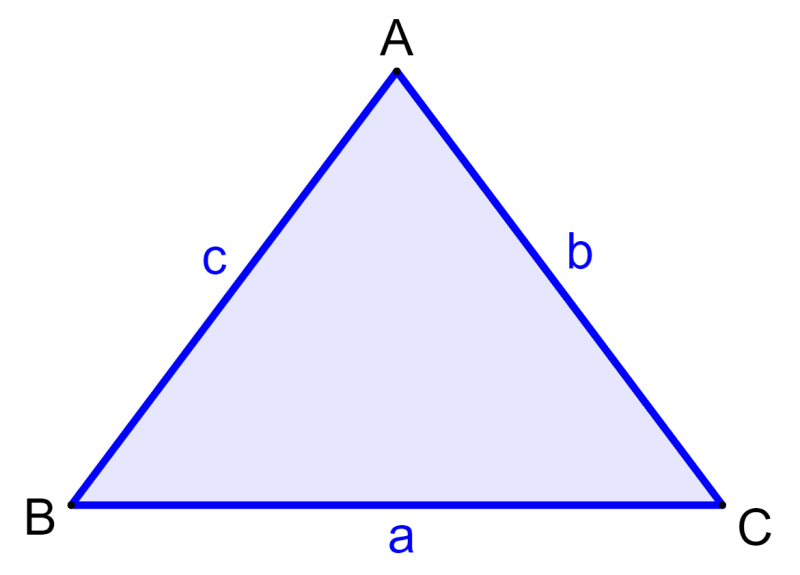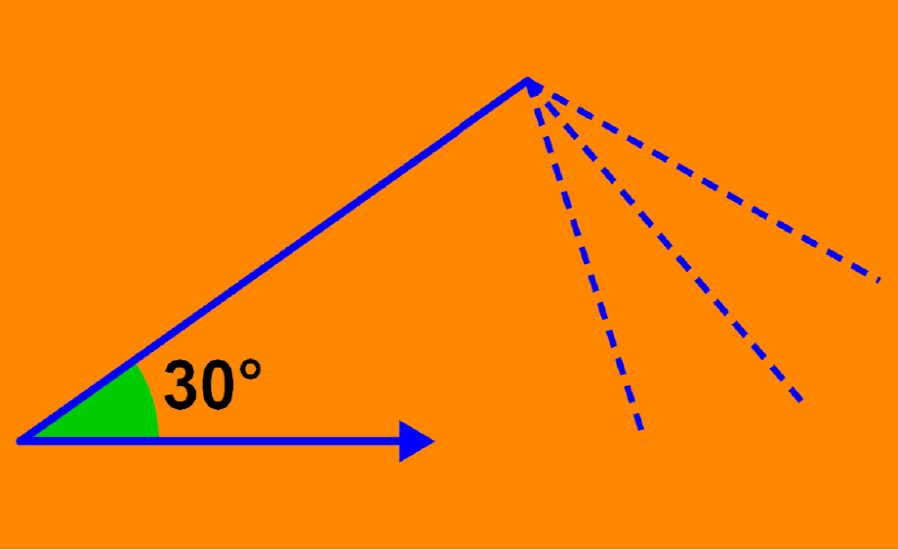The law of sines indicates that the ratio of the sides of a triangle and the ratio of the sines of the respective angles are equivalent to each other. The law of sines is used to find an unknown angle or side of a triangle that is not a right triangle. The law of sines relates to at least two angles and the measurements of their respective sides.
Here, we will learn about the formula for the law of sines. We will also learn to derive this formula and apply it to solve some practice problems.
Formula for the law of sines
The law of sines formula relates the ratios of the sides of a triangle to the sines of their corresponding angles. Therefore, we have:
| $latex \frac{a}{\sin(A)}=\frac{b}{\sin(B)}=\frac{c}{\sin(C)}$ |
Here, a, b, c are the lengths of the sides of the triangle, and A, B, C are the angles of the triangle. Each side of the triangle is denoted with respect to its opposite angle. For example, a is the side opposite angle A, b is the side opposite angle B, and c is the side opposite angle C.

When does the law of sines apply?
Trigonometric functions like sine, cosine, and tangent are important functions that are used to find unknown angles or sides of a triangle. The law of sines applies in the following situations:
- It can be used to find the other side of a triangle when we know the measure of two angles and the length of one side.
- It can be used to calculate an angle when we know the measure of two sides and an angle.
With the law of sines, we relate the angles to their opposite sides. Therefore, using the following triangle, we can apply the law of sines if we know the measure of angles A, B, and the length of side a and we want to find the length of side b.
Also, we can find the measure of angle A if we know the lengths of the sides a, b, and the measure of angle B.

How to prove the law of sines?
We can prove the law of sines using the following two triangles:

Recall that the sine of an angle in a triangle is equal to the opposite side divided by the hypotenuse. Therefore, in the first triangle, we have:
$latex \frac{h}{b}=\sin(A)$
$latex h=b~\sin(A)$
Similarly, in the second triangle, we have:
$latex \frac{h}{a}=\sin(B)$
$latex h=a~\sin(B)$
We got two expressions for h. If we equal both expressions, we have:
$latex a~\sin(B)=b~\sin(A)$
$latex \frac{a}{\sin(A)}=\frac{b}{\sin(B)}$
Following the same process, we can derive a relation for $latex \sin(A)$ and $latex \sin(C)$. Therefore, we have:
$latex a~\sin(C)=c~\sin(A)$
$latex \frac{a}{\sin(A)}=\frac{c}{\sin(C)}$
By combining the two expressions obtained, we have the law of sines:
$latex \frac{a}{\sin(A)}=\frac{b}{\sin(B)}=\frac{c}{\sin(C)}$
Law of sines – Examples with answers
The formula for the law of sines is used to solve the following examples. Each of the examples has its respective solution, but it is recommended that you try to solve the problems yourself before looking at the answer.
EXAMPLE 1
If we have angles A=30° and B=40° and we have the side $latex a = 10$, what is the length of side b?
Solution
We start by recognizing the information we have:
- A=30°
- B=40°
- a=10
We use the law of sines and solve for b:
$latex \frac{a}{\sin(A)}=\frac{b}{\sin(B)}$
$latex \frac{10}{\sin(30)}=\frac{b}{\sin(40)}$
$latex \frac{10}{0.5}=\frac{b}{0.643}$
$latex 5=\frac{b}{0.643}$
$latex b=5(0.643)$
$latex b=3.2$
The length of b is 3.2.
EXAMPLE 2
We have the angles B=50° and C=35°. If the length of b is 8, what is the length of c?
Solution
We have the following:
- B=50°
- C=35°
- b=8
Using these values in the given formula, we have:
$latex \frac{b}{\sin(B)}=\frac{c}{\sin(C)}$
$latex \frac{8}{\sin(50)}=\frac{c}{\sin(35)}$
$latex \frac{10}{0.766}=\frac{c}{0.574}$
$latex 13.05=\frac{c}{0.574}$
$latex c=13.05(0.574)$
$latex c=7.75$
The length of c is 7.75.
EXAMPLE 3
What is the value of A if we have a=8, B=30°, and b=7?
Solution
In this case, we have two angles and one side:
- a=8
- B=30°
- b=7
We use the given formula with these values:
$latex \frac{a}{\sin(A)}=\frac{b}{\sin(B)}$
$latex \frac{8}{\sin(A)}=\frac{7}{\sin(30)}$
$latex \frac{8}{\sin(A)}=\frac{7}{0.5}$
$latex \frac{8}{\sin(A)}=14$
$latex \sin(A)=\frac{8}{14}$
Now, we use the inverse sine function to find the value of the angle.
$latex A={{\sin}^{-1}}(\frac{8}{14})$
$latex A=34.8$°
Angle A measures 34.8°.
EXAMPLE 4
We have the angles A=47° and B=78° and we have the longitude c=6.3. What is the length of a?
Solution
We have the following values:
- A=47°
- B=78°
- c=6.3
We have a side that does not correspond to any of the given angles, so we have to find the third angle. We know that the interior angles of a triangle add up to 180°, so we have:
$latex A+B+C=180$
$latex 47+78+C=180$
$latex C=180-47-78$
$latex C=55$
Now, we can use the law of sines with all the values we have:
$latex \frac{a}{\sin(A)}=\frac{c}{\sin(C)}$
$latex \frac{a}{\sin(47)}=\frac{6.3}{\sin(55)}$
$latex \frac{a}{0.73}=\frac{6.3}{0.82}$
$latex \frac{a}{0.73}=7.68$
$latex a=7.68(0.73)$
$latex a=5.6$
Side a measures 5.6.
Law of sines – Practice problems
Use the formula for the law of sines to solve the following practice problems. Select an answer and click “Verify” to check that you got the correct answer.
See also
Interested in learning more about the law of sines and cosines? Take a look at these pages:




